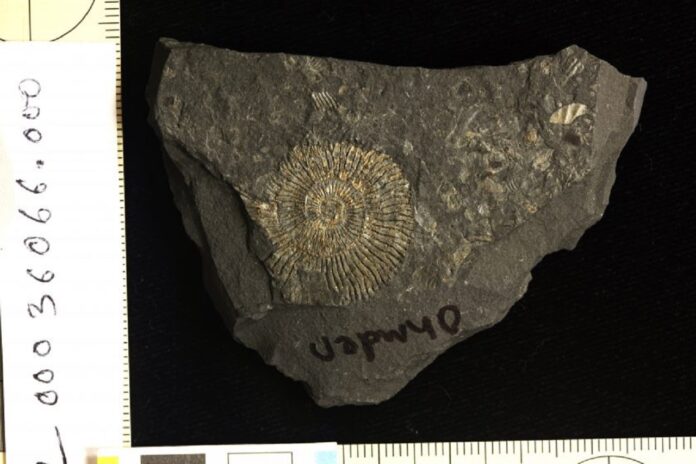The marine fossil record demonstrates that biomineralized materials are more common than the remains of labile (non-biomineralized) tissues. This is because of the physiological, chemical, and biological changes that occur in an organism’s body just before it dies.
Transport, fracture, and disarticulation of fragile morphological features and multi-element skeletons are facilitated by predation, scavenging, and other physical pressures.
In a new study, researchers from the University of Texas at Austin and colleagues discovered that pyrite, sometimes known as fool’s gold, is not the primary source of the shine on many fossils found in Germany’s Posidonia shale. Instead, a combination of minerals gives the fossils golden color, hinting at the conditions under which they formed.
The finding is important for understanding how the fossils, among the best-preserved examples of Early Jurassic marine life anywhere in the world, formed in the first place and environmental oxygen’s role in their creation.
Study co-author Rowan Martindale, an associate professor at the UT Jackson School of Geosciences, said, “When you go to the quarries, golden ammonites peek out from black shale slabs, But surprisingly, we struggled to find pyrite in the fossils. Even the fossils that looked golden are preserved as phosphate minerals with yellow calcite. This dramatically changes our view of this famous fossil deposit.”
The Posidonia Shale contains unusual soft-bodied fossils from 183 million years ago, including lobsters, embryos of ichthyosaurs, and squids with ink sacs.
The researchers studied the chemical composition of dozens of samples using scanning electron microscopes to learn more about the fossilization circumstances that resulted in such excellent preservation.
Co-author Jim Schiffbauer, an associate professor at the University of Missouri Department of Geological Sciences, who handled some of the larger samples, said, “I couldn’t wait to get them in my microscope and help tell their preservational story.”
The fossils were mostly composed of phosphate minerals, according to researchers at the University of Missouri Department of Geological Sciences, despite microscopic framboid clusters of pyrite crystals in the nearby black shale rock.
Co-author Sinjini Sinha, a doctoral student at the Jackson School, said, “I spent days looking for the framboids on the fossil; for some of the specimens, I counted 800 framboids on the matrix while there was maybe three or four on the fossils.”
Pyrite and phosphate are present in the specimens in various locations. This is significant because it provides essential information about the fossilization environment. While phosphate minerals require oxygen, pyrite can form in anoxic conditions (where there is no oxygen).
This shows that even while an anoxic seafloor creates the ideal conditions for fossilization, the chemical reactions necessary for fossilization require a brief burst of oxygen.
The findings support past work by the researchers on the geochemical conditions of conservator-lagerstätten, locations noted for their collections of extraordinarily well-preserved fossils. However, the results of these studies contradict long-held theories about the conditions required for exceptional fossil preservation in the Posidonia.
Sinha said, “It’s been thought for a long time that the anoxia causes the exceptional preservation, but it doesn’t directly help. It helps with making the environment conducive to faster fossilization, which leads to the preservation, but it’s oxygenation that’s enhancing preservation.”
As it turns out, the fossil’s shine was also improved by oxygenation, phosphate, and the surrounding minerals.
The research was funded by Cornell College and the National Science Foundation.
Journal Reference:
- Muscente, A., Vinnes, O., Sinha,etal. What role does anoxia play in exceptional fossil preservation? Lessons from the taphonomy of the Posidonia Shale. Earth-Science Reviews. DOI: 10.1016/j.earscirev.2023.104323
